Knowledge Management System: The Ultimate Guide
A Knowledge Management System can store and share all the company's valuable knowledge. A KMS ensures everyone has what they need to succeed, boosting productivity and innovation.

A Knowledge Management System can store and share all the company's valuable knowledge. A KMS ensures everyone has what they need to succeed, boosting productivity and innovation.

Ever struggled to find important information within the organization, or spent hours searching for relevant documents? If so, businesses may benefit from implementing a knowledge management system.
Organizations are constantly seeking ways to effectively manage and share knowledge. A KM system simplifies the sharing of information in a company by streamlining data collection and distribution. 74% of organizations estimate that effective knowledge management disciplines increase company productivity by 10-40%.
We can say that a well-designed system can improve collaboration, decision-making and organizational productivity. The article explores the benefits of implementing it and best practices for successful implementation.
Knowledge management meaning refers to capturing, organizing and sharing information to improve organizational efficiency. It involves the systematic process of creating, acquiring, storing and using knowledge to benefit the organization. Knowledge management enhances collaboration, innovation and learning by utilizing the collective intelligence of individuals in the organization.
The impact of knowledge management in organizations is transformative as it leads to faster decision-making, reduced duplication of efforts and enhanced innovation through better access to institutional wisdom. Businesses implementing effective knowledge management systems typically experience improved employee productivity, accelerated onboarding processes and stronger competitive advantages through the strategic leveraging of their intellectual capital.
Key principles:
A knowledge management system (KMS) refers to a software platform or framework that helps organizations capture, store and share information within the organization. Employees can access and contribute to a shared knowledge base, promoting collaboration across teams. KMSs enhance decision-making, innovation and efficiency by centralizing knowledge access for organizations.
A KMS works by creating a centralized digital repository where information flows through systematic processes of collection, organization and distribution. The system captures knowledge from various sources including documents, expert insights and team experiences. It then structures the information obtained using taxonomies and metadata to make it easily accessible to authorized users.
Key factors:
Below, we will cover the knowledge management system types and their significance within a KM system.
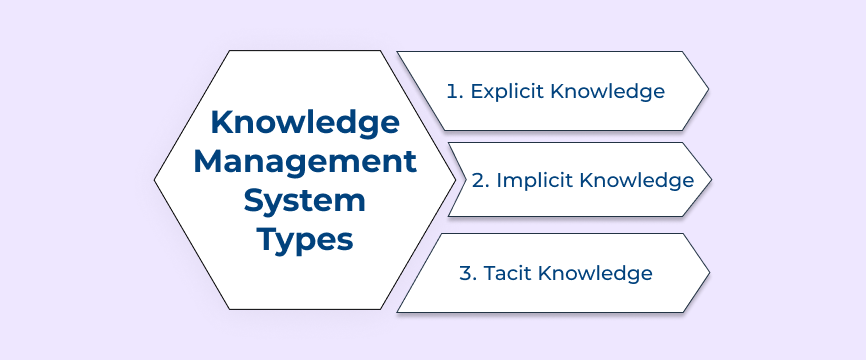
Explicit knowledge is information that is easily codified, documented and shared. It includes facts, figures, procedures and other tangible data that can be written down or stored in a digital format.
Including explicit knowledge in a knowledge management system is crucial. It provides employees with easy access to information that is vital for their roles. Employees can find answers, make decisions and perform tasks efficiently with readily available information.
Implicit knowledge refers to knowledge that is difficult to articulate, codify or transfer to others. It is often based on personal experiences, intuition and insights that come from years of practice.
While implicit knowledge may be challenging to document, it is essential to include in a knowledge management system. It can provide valuable insights that can help solve complex problems and drive innovation within an organization.
Tacit knowledge is the type of knowledge that is deeply rooted in an individual’s mind and is often difficult to explain or transfer to others. It is based on personal beliefs and perspectives that shape an individual’s understanding of their work environment.
Including tacit knowledge in a knowledge management system is crucial. It can help enhance a culture of knowledge sharing and collaboration within an organization. Sharing tacit knowledge allows employees to enhance skills and gain deeper work understanding.
Below are the key benefits a knowledge management system can bring to your organization and why adopting one should be on every leader’s agenda.
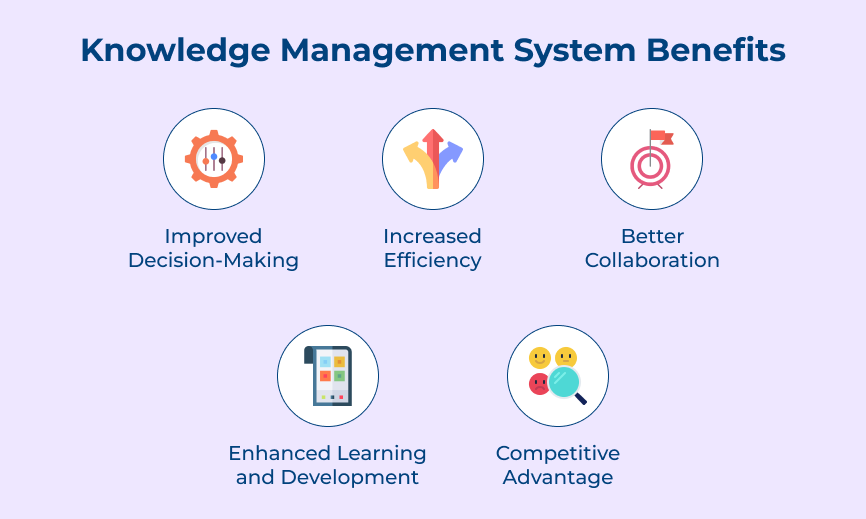
Knowledge management systems allow employees to easily access information and data that is relevant to their work. It can help employees make more informed decisions as they have access to the necessary information to guide their choices. Having a centralized system for knowledge sharing can ensure that decisions are based on accurate and up-to-date information.
Employees can quickly find the information they need to complete tasks and projects with a knowledge management system in place. It can lead to increased efficiency and productivity within the organization. Employees can spend less time searching for information and more time working on important tasks. The KM system can help employees avoid duplicating work that has already been done, saving time and resources.
Knowledge management systems facilitate collaboration and communication among employees. Employees can work together more effectively and share insights by sharing information through the system. It can lead to improved teamwork within the organization, as employees can learn from each other and build on each other’s knowledge.
Knowledge management systems can also be used as a tool for learning and development within an organization. Employees can enhance skills by accessing training, best practices and educational resources in the system. Continuous learning can help employees grow professionally and stay up-to-date on industry trends.
Organizations can gain a competitive advantage by implementing a knowledge management system. Employees can respond more quickly to changes in the industry and make better decisions with easier access to information. It can help the organization stay ahead of the competition and adapt to new challenges more effectively.
A knowledge management system (KMS) delivers significant value to different professionals. Here are five key points on who uses a km system and how they use it:
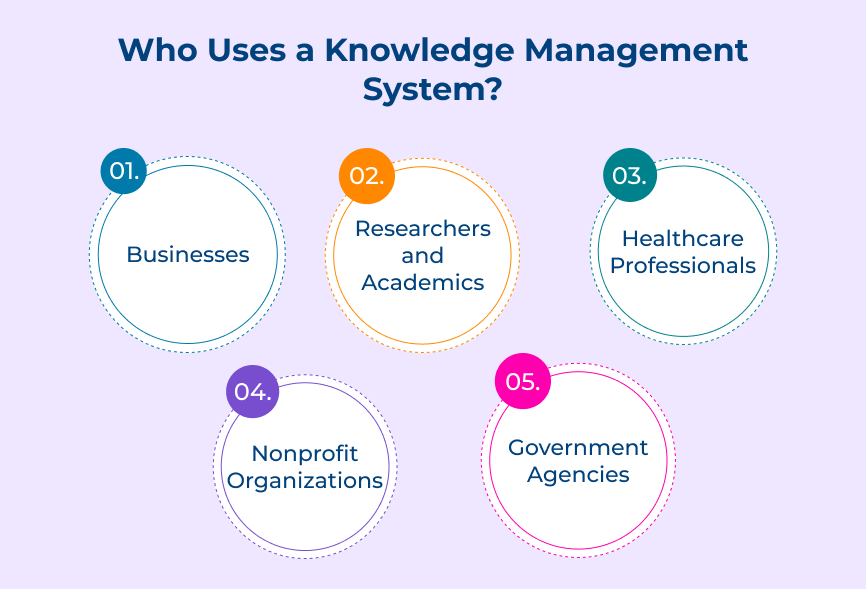
1. Businesses: Businesses of all sizes use KMS to store, organize and access important knowledge. It includes documents, policies, procedures, customer data and more. Implementing a KMS can improve collaboration, decision-making and overall productivity.
2. Researchers and academics: Researchers and academics rely on KMS to share scholarly articles or research papers. A KMS allows them to easily collaborate with colleagues, access relevant information and stay up-to-date on the latest developments.
3. Healthcare professionals: Healthcare professionals use KMS to securely store patient information, medical records and research findings. A KMS assists healthcare firms in enhancing care, streamlining communication and ensuring regulatory compliance like HIPAA.
4. Nonprofit organizations: Nonprofit organizations utilize KMS to manage donor information, fundraising campaigns and program evaluation data. Nonprofits can enhance transparency, accountability and impact by centralizing knowledge.
5. Government agencies: Government agencies use KMS to share important documents, policies, regulations and data. A KMS enables government employees to access critical information quickly. It improves decision-making processes and enhances transparency.
Let us go through the practical steps to help you build a KMS that actually works for your team and your business.
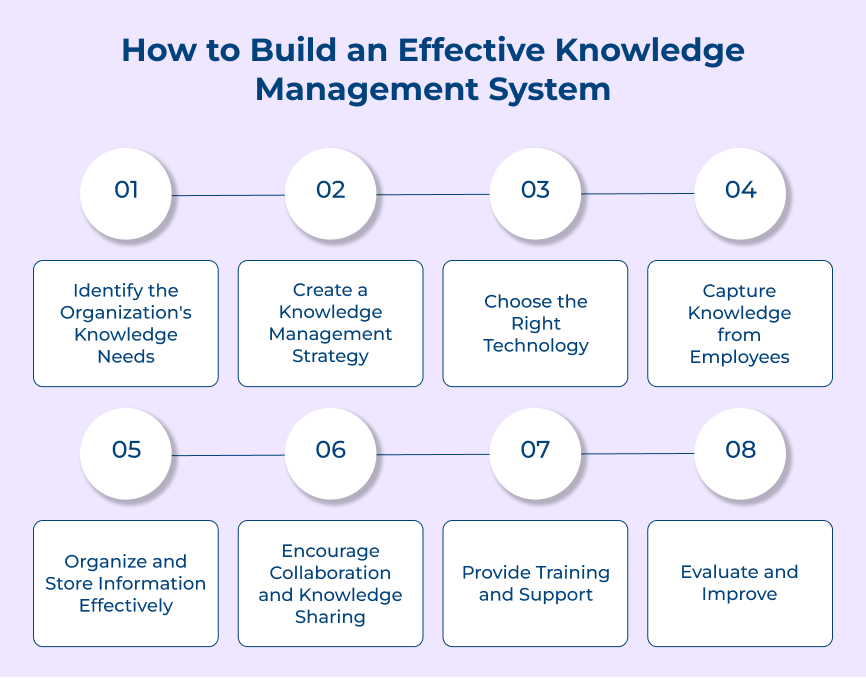
Identifying the organization’s knowledge needs is a crucial step in building an effective knowledge management system. We recommend you should assess what information and skills are required to support the organization’s goals. Businesses can then implement strategies to capture, share and utilize knowledge effectively by understanding the knowledge needs.
One example of identifying knowledge needs could be conducting a skills gap analysis within the organization. It involves evaluating the current skills of employees and identifying areas where additional knowledge is needed to fulfill job responsibilities.
Actionable tips:
Creating a knowledge management strategy is essential in building an effective knowledge management system. The process includes identifying an organization’s information needs, collecting knowledge and establishing sharing procedures. 75% of the organizations believe knowledge management is important for their corporate strategy.
One example of creating a knowledge management strategy is conducting a knowledge audit to assess the current state of knowledge. It can help identify areas where knowledge is lacking or where processes can be improved.
Actionable tips:
Choosing the right technology is a crucial step in building an effective knowledge management system. Technology plays a key role in organizing, storing and sharing knowledge within an organization. Choosing the right technology can streamline processes, boost collaboration and improve information access.
There are various technologies available for km systems. Intranet portals, document management systems and collaboration tools are the main ones. Let’s assume that a company may choose to implement a cloud-based document management system to centralize and manage all documents.
Actionable tips:
Capturing knowledge from employees is a crucial step in building an effective knowledge management system for any organization. Businesses can enhance processes, solve problems and innovate by leveraging employees’ expertise for valuable insights.
One way to capture knowledge from employees is through regular brainstorming sessions, team meetings, or one-on-one discussions. It can help employees share their ideas, best practices and lessons learned. Another method is to encourage employees to document their knowledge and insights in a digital platform. It can be easily accessed later and shared among team members.
Actionable tips:
When it comes to building an effective knowledge management system, organizing and storing information effectively is crucial. It involves categorizing and structuring information in a way that is easily accessible for employees. Organizing information effectively can improve collaboration, decision-making and overall efficiency.
Let’s consider, a company may choose to use a centralized database to store all documents, reports and data in one location. It allows employees to quickly locate the information they need and ensures that everyone is working from the same source of truth.
Actionable tips:
Encouraging collaboration and knowledge sharing is a crucial step in building an effective knowledge management system within an organization. Enhancing a culture of shared learning among employees promotes knowledge-sharing and accessibility for all team members.
Let’s assume that a company encourages collaboration and knowledge sharing. It may set up regular team meetings where employees can share their insights and experiences. It results in cross-functional learning and a more informed decision-making process.
Actionable tips:
“Provide training and support” is a crucial step in building an effective knowledge management system. Training and ongoing support help employees manage system information effectively by equipping them with the necessary skills. It helps in building an effective KM system by encouraging user adoption and improving employee efficiency.
Let’s consider that a company may offer training sessions on how to properly input information within the km system. It may also provide ongoing support through a designated help desk or knowledge management team.
Actionable tips:
“Evaluate and Improve” are crucial steps in building an effective knowledge management system. It involves assessing current knowledge management practices and identifying improvement areas. Evaluating can optimize their knowledge-sharing processes, enhance collaboration among employees and drive innovation.
Let’s assume that a company might evaluate its existing knowledge management tools and processes, and identify gaps in information sharing. It can implement new technologies to improve knowledge capture, storage and dissemination.
Actionable tips:
Let us go through the emerging trends and technologies that will shape the future of knowledge management systems.
AI and machine learning algorithms are being used to analyze vast amounts of data, identify patterns and trends. It helps organizations better organize and utilize their knowledge assets. The system helps employees access essential job information more easily.
One exciting trend in knowledge management systems is the integration of chatbots and virtual assistants. The intelligent tools enable instant access to knowledge, answer questions and guide through procedures. Leveraging chatbots and virtual assistants can streamline the knowledge access process.
Another key development in the future of knowledge management systems is the personalization and customization of knowledge delivery. Customizing knowledge resources for employees ensures information is delivered in a relevant manner for each user. It enhances learning, retention and engagement with the KM system holistically.
Here are the four knowledge management system examples of brands that have effectively implemented KM systems:
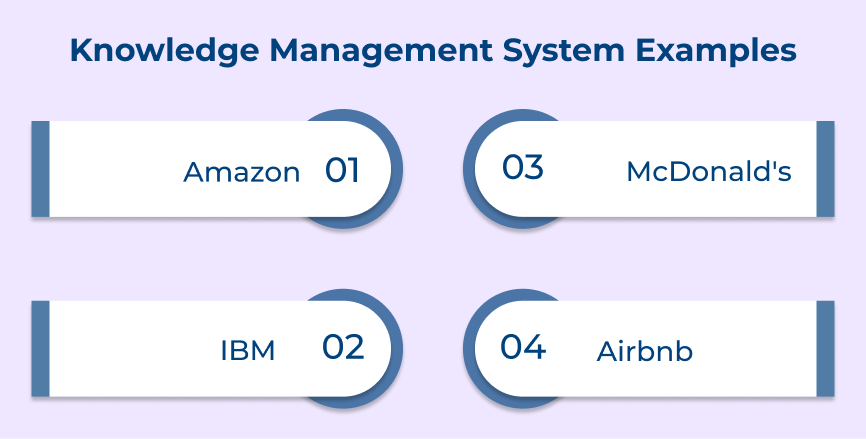
1. Amazon
Amazon has implemented a robust knowledge management system. It enhances customer service and streamline internal operations. The company’s knowledge base allows customer service representatives to access up-to-date information. It also provides timely solutions to customer inquiries.
Amazon’s employees have access to a centralized repository of knowledge. It enables them to collaborate effectively and share best practices. Amazon improved customer satisfaction, decreased resolution times and boosted employee efficiency.
2. IBM
IBM, a multinational technology company, has implemented a knowledge management system to leverage its vast intellectual capital and drive innovation. IBM’s KM system integrates various tools to capture, store and share knowledge across the organization.
Employees can access expert insights, collaborate on projects and leverage past experiences to solve current challenges. IBM has seen tangible benefits from its km system. It includes faster product development cycles, improved decision-making processes and enhanced employee engagement.
3. McDonald’s
McDonald’s, the global fast-food chain, has implemented a knowledge management system to standardize operational practices. It ensures consistent customer experiences across its locations. McDonald’s KM system offers accessible training modules and best practices for employees at all levels.
McDonald’s has improved service quality and reduced training costs by providing employees with easy access to critical information. The km system has also facilitated knowledge sharing and collaboration among franchise owners. It enabled them to learn from each other’s successes and challenges.
4. Airbnb
Airbnb, the online marketplace uses a knowledge management system to offer personalized experiences to users. Airbnb’s knowledge base includes detailed property listings, guest reviews and host resources. It enabled users to make informed decisions and enjoy memorable stays.
The company’s KM system uses machine learning to suggest personalized recommendations and improve search results. Airbnb has seen increased user satisfaction, higher booking rates and enhanced brand loyalty.
The terms knowledge management and knowledge management system are often used interchangeably, but they aren’t quite the same. Following is the breakdown of what each term means and how they work together.
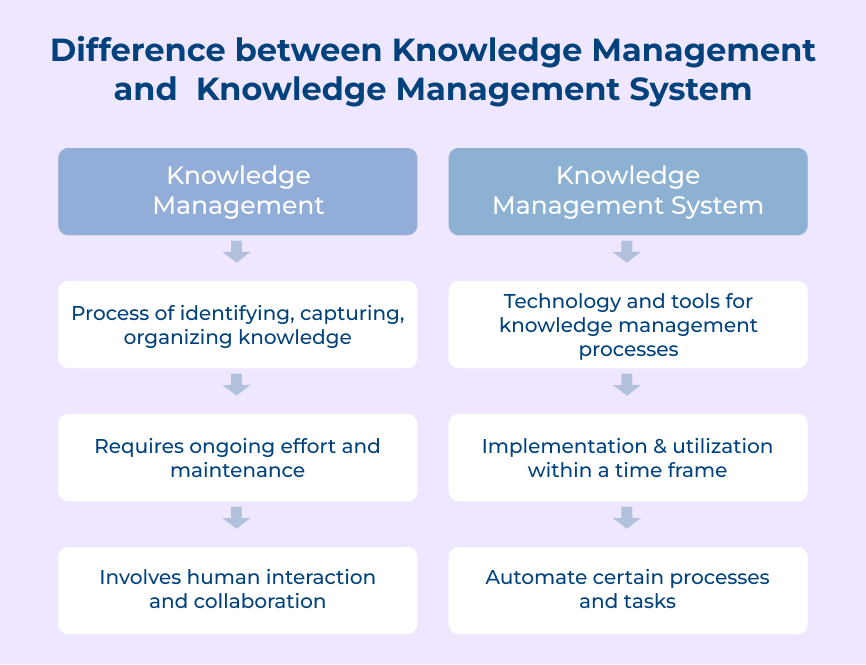
Knowledge management encompasses a wide range of activities, including knowledge creation, codification and application. Creating a knowledge-sharing culture, repositories and transfer best practices within an organization are involved.
A knowledge management system is a more focused tool that helps organizations manage their knowledge assets more effectively. It provides a platform for storing, organizing and accessing knowledge resources. But it is not a substitute for a comprehensive knowledge management strategy.
The primary purpose of knowledge management is to leverage knowledge as a strategic asset for competitive advantage. It aims to boost organizational performance, decision-making and innovation through knowledge sharing.
A knowledge management system is designed to facilitate the implementation of knowledge management practices within an organization. It helps streamline knowledge-related processes, improve access to information and promote collaboration.
Knowledge management involves a variety of components, including people, processes, technology and culture. Employees at all levels must actively participate, aligning knowledge management initiatives with business goals.
A knowledge management system consists of specific tools and technologies that support knowledge management activities. It may include features such as document management, social networking and collaboration tools.
Implementing a knowledge management system is just one aspect of a broader knowledge management strategy. A KM system can provide organizations with the necessary tools and infrastructure for managing knowledge. It is important to have the right processes and practices in place to ensure its success.
Knowledge management involves a more holistic approach that encompasses organizational culture, leadership and learning. It requires a long-term commitment from top management and ongoing support from all employees to be successful.
Let us go through the essential practices that can help you implement a KMS that empowers your team and enhances your organization’s intellectual resources.
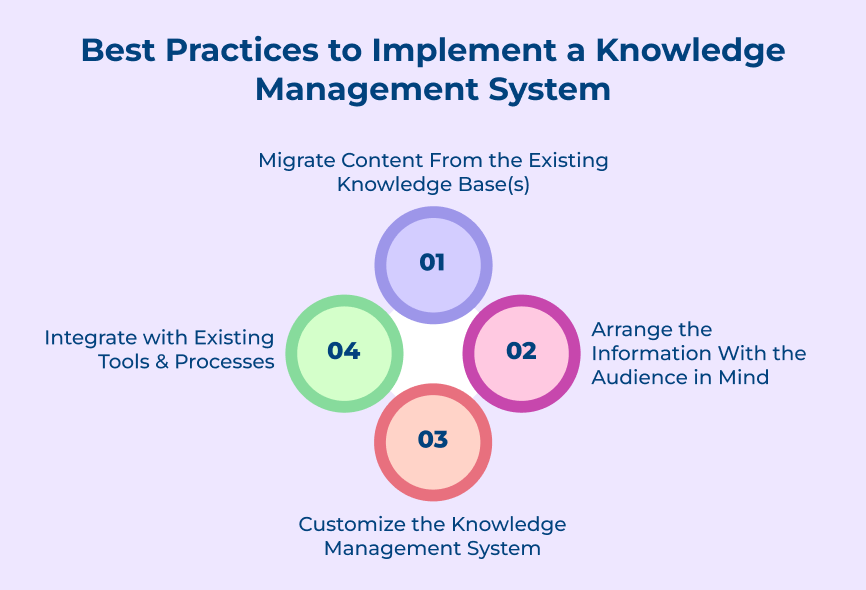
Before upgrading to a new knowledge management system, it is important to migrate content for a seamless transition. It helps in consolidating information and prevents the loss of valuable knowledge. Businesses can maintain consistency and avoid duplication, by transferring relevant content. It allows employees to easily access and leverage knowledge.
When organizing information within the knowledge management system, it is essential to consider the needs of the audience. Categorizing information in a user-friendly way can enhance usability and facilitate easy navigation. Customizing content for diverse user groups enhances engagement and enhances knowledge sharing.
Every organization has unique requirements and objectives when it comes to knowledge management. Customizing the knowledge management system to align with the organization’s culture, workflows and goals is crucial. Customizing the system for the organization can optimize effectiveness and integrate smoothly with existing processes.
Enhance the adoption and usability of the knowledge management system. It is important to integrate it with existing tools and processes within the organization. Integrating the KM system with CRM communication tools streamlines workflows. Integration helps in creating a unified and cohesive work environment, promoting collaboration.
Following are the must-have features of a knowledge management system that can help your organization thrive in a knowledge-driven economy.
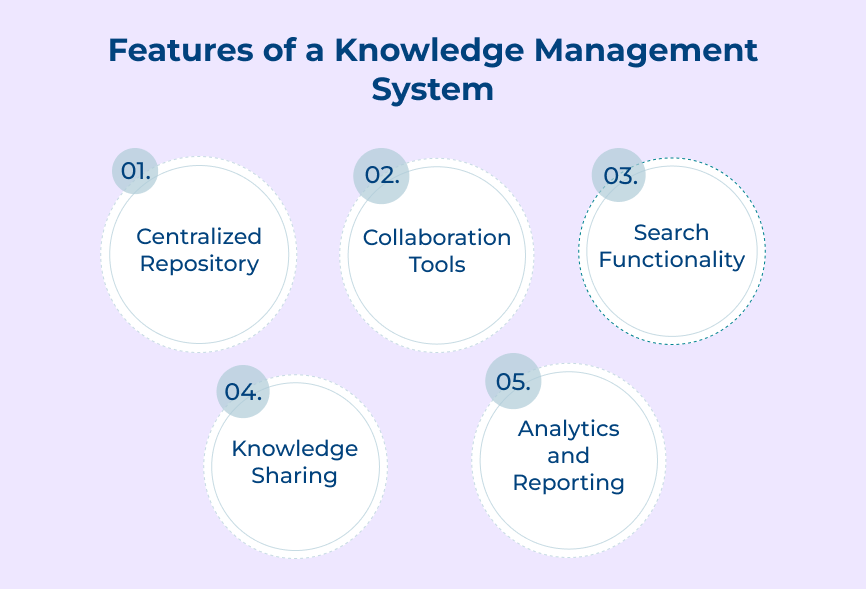
1. Centralized repository: A knowledge management system must centrally store and organize knowledge assets for easy access. The repository should be able to accommodate content, such as documents, images, videos and presentations. It allows users to access information quickly and efficiently.
2. Collaboration tools: Collaboration is key to effective knowledge management. So it’s important for a knowledge management system to offer features that enable collaboration. It could include tools for real-time communication and project management. The feature allows users to work together seamlessly and share knowledge effectively.
3. Search functionality: A robust search functionality is essential for a knowledge management system. It allows users to quickly find the information they need. The search feature should allow users to search easily by keywords, categories and more. Advanced search capabilities, such as filters and sorting options, can further enhance the user experience.
4. Knowledge sharing: An effective knowledge management system should facilitate knowledge sharing among employees. It encourages a culture of learning and collaboration within the organization. Discussion forums, social tools and knowledge-sharing help employees share expertise.
5. Analytics and reporting: Analytics and reporting features measure how knowledge assets are used in a knowledge management system. The features can help identify trends, track user engagement and assess the overall performance of the system. It allows organizations to make data-driven decisions and optimize their knowledge management strategies.
Veemo’s knowledge management system offers a valuable solution for streamlining information sharing within an organization. Veemo’s platform can greatly improve efficiency by centralizing knowledge resources and enhancing collaboration.
Employees can access vital information easily and track changes to make informed decisions. Veemo’s KM System is a powerful tool for enhancing communication, streamlining processes and achieving success.
Knowledge management systems typically consist of four main components: knowledge capture, knowledge storage, knowledge dissemination and knowledge utilization. Knowledge capture involves gathering information from various sources. Knowledge storage involves organizing and storing the information. Knowledge dissemination ensures that knowledge is shared effectively within an organization. Knowledge utilization involves using knowledge to improve processes and decision-making.
The implementation time for a KMS in an organization can vary based on size, system complexity and customization needs. It can take anywhere from a few weeks to several months to fully implement a KMS successfully.
Knowledge management systems are tools used to capture, store and share information within an organization. Some major km systems include document management systems and learning management systems. The systems help employees access organizational knowledge, leading to increased productivity and efficiency.
A knowledge management system in business is a tool that helps to organize, share and analyze information within an organization. Employees can access knowledge, collaborate on projects and enhance decision-making processes. A KM system streamlines operations, boosts productivity through centralizing information, enhancing knowledge sharing.
A Knowledge Management System (KMS) improves customer experience through efficient information access and quicker problem-solving. KMS helps create a better customer experience through improved efficiency in serving customers. It ensures that employees have the necessary knowledge at their fingertips.

Market better, sell faster and support smarter with Veemo’s Conversation Customer Engagement suite of products.
Unify all your customer data in one platform to deliver contextual responses. Get a 360 degree view of the customer lifecycle without switching tools.
Connect with the tools you love to reduce manual activities and sync your business workflows for a seamless experience.
 https://veemo.io/wp-content/uploads/2024/12/customer-service-response-time.png
1256
2400
Webvision Solution
https://veemo.io/wp-content/uploads/2024/11/veemo.svg
Webvision Solution2025-10-17 10:51:142025-10-17 10:51:149 Effective Tips to Reduce Customer Service Response Time
https://veemo.io/wp-content/uploads/2024/12/customer-service-response-time.png
1256
2400
Webvision Solution
https://veemo.io/wp-content/uploads/2024/11/veemo.svg
Webvision Solution2025-10-17 10:51:142025-10-17 10:51:149 Effective Tips to Reduce Customer Service Response Time https://veemo.io/wp-content/uploads/2024/10/How-to-Create-Knowledge-Base.png
1257
2400
Vikas Sachan
https://veemo.io/wp-content/uploads/2024/11/veemo.svg
Vikas Sachan2024-10-21 12:24:342025-11-03 07:13:21How to Create a Knowledge Base in 9 Easy Steps: The Ultimate Guide
https://veemo.io/wp-content/uploads/2024/10/How-to-Create-Knowledge-Base.png
1257
2400
Vikas Sachan
https://veemo.io/wp-content/uploads/2024/11/veemo.svg
Vikas Sachan2024-10-21 12:24:342025-11-03 07:13:21How to Create a Knowledge Base in 9 Easy Steps: The Ultimate Guide https://veemo.io/wp-content/uploads/2024/02/Live-Chat-for-Sales.png
628
1200
teamwebvisionsolution@gmail.com
https://veemo.io/wp-content/uploads/2024/11/veemo.svg
teamwebvisionsolution@gmail.com2024-10-21 11:31:222025-08-06 10:22:06How to Use Live Chat for Sales? 7 Proven Ways to Grow Revenue
https://veemo.io/wp-content/uploads/2024/02/Live-Chat-for-Sales.png
628
1200
teamwebvisionsolution@gmail.com
https://veemo.io/wp-content/uploads/2024/11/veemo.svg
teamwebvisionsolution@gmail.com2024-10-21 11:31:222025-08-06 10:22:06How to Use Live Chat for Sales? 7 Proven Ways to Grow RevenueGrow Customer Relationships and stronger team collaboration with our range of products across the Conversational Engagement Suite.
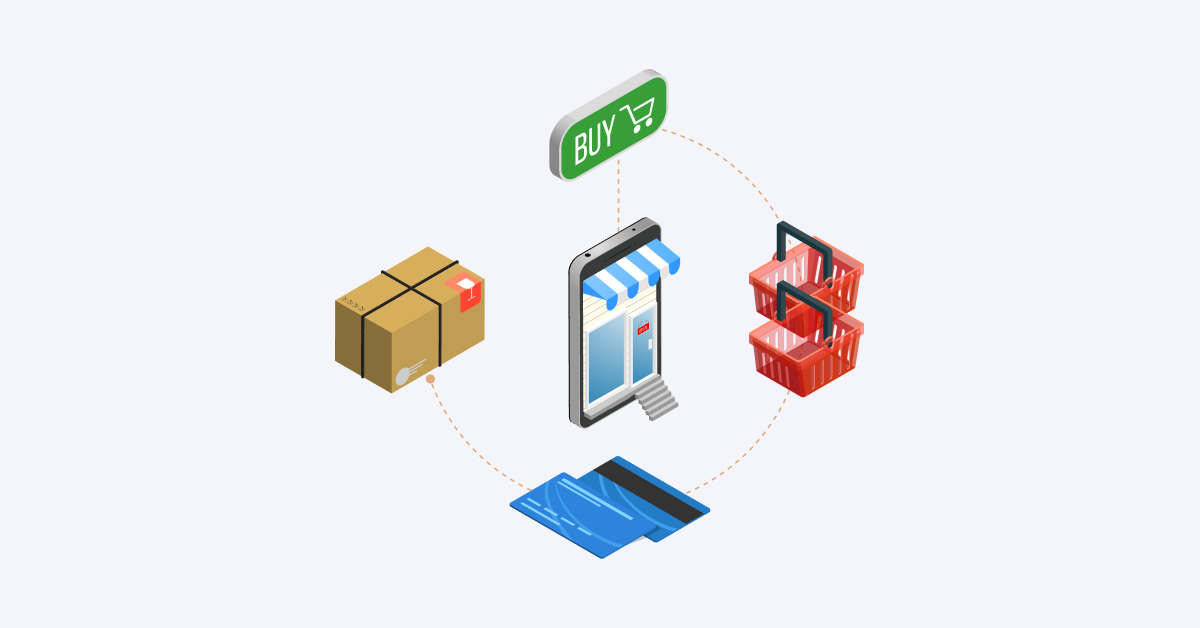
 Effective Customer Interaction: Types, Benefits & Tips
Scroll to top
Effective Customer Interaction: Types, Benefits & Tips
Scroll to top